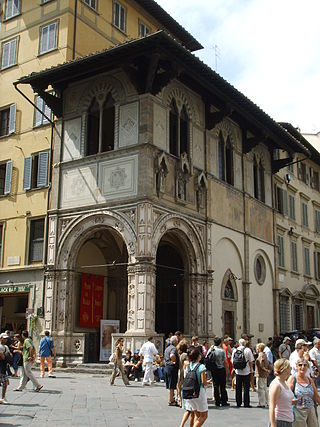
Khmer architecture, also known as Angkorian architecture, is the architecture produced by the Khmers during the Angkor period of the Khmer Empire from approximately the later half of the 8th century CE to the first half of the 15th century CE.

The province of Benevento is a province in the Campania region of Italy. Its capital is the city of Benevento.

Labna is a Mesoamerican archaeological site and ceremonial center of the pre-Columbian Maya civilization, located in the Puuc Hills region of the Yucatán Peninsula. It is situated to the south of the large Maya site of Uxmal, in the southwest of the present-day state of Yucatán, Mexico. It was incorporated with Uxmal as a UNESCO World Heritage Site in 1996.

Relief is a sculptural method in which the sculpted pieces remain attached to a solid background of the same material. The term relief is from the Latin verb relevare, to raise. To create a sculpture in relief is to give the impression that the sculpted material has been raised above the background plane. When a relief is carved into a flat surface of stone or wood, the field is actually lowered, leaving the unsculpted areas seeming higher. The approach requires a lot of chiselling away of the background, which takes a long time. On the other hand, a relief saves forming the rear of a subject, and is less fragile and more securely fixed than a sculpture in the round, especially one of a standing figure where the ankles are a potential weak point, particularly in stone. In other materials such as metal, clay, plaster stucco, ceramics or papier-mâché the form can be simply added to or raised up from the background. Monumental bronze reliefs are made by casting.

Jvari Monastery is a sixth-century Georgian Orthodox monastery near Mtskheta, eastern Georgia. Jvari is a rare case of an Early Medieval Georgian church that has survived to the present day almost unchanged. The church became the founder of its type, the Jvari type of church architecture, prevalent in Georgia and Armenia. Built atop of Jvari Mount, the monastery is an example of harmonious connection with the natural environment, characteristic to medieval Georgian architecture. Along with other historic structures of Mtskheta, the monastery was listed as a World Heritage Site by UNESCO in 1994.

Sabratha, in the Zawiya District of Libya, was the westernmost of the ancient "three cities" of Roman Tripolis, alongside Oea and Leptis Magna. From 2001 to 2007 it was the capital of the former Sabratha wa Sorman District. It lies on the Mediterranean coast about 70 km (43 mi) west of modern Tripoli. The extant archaeological site was inscribed as a UNESCO World Heritage Site in 1982.

The Arrondissement of Molsheim is an arrondissement of France in the Bas-Rhin department in the Grand Est region. It has 77 communes. Its population is 103,633 (2016), and its area is 771.2 km2 (297.8 sq mi).

The Chitharal Jain Monuments and Bhagavati Temple, also known as Chitharal Malai Kovil, Chitaral Cave Temple or Bhagavati Temple, are located near Chitharal village in Kanyakumari district, Tamil Nadu, India. They consist of stone beds with inscriptions, and two monuments – one rock cut Jain temple with outer wall reliefs and one Hindu goddess temple next to it that is a combination of rock-cut and stone that was added during the reign of Vikramaditya Varaguna Pandya. The monuments are from the 9th century CE.

The Borghese Vase is a monumental bell-shaped krater sculpted in Athens from Pentelic marble in the second half of the 1st century BC as a garden ornament for the Roman market; it is now in the Louvre Museum.

Bokator or Kun L'Bokator is an ancient Cambodian battlefield martial art used by the ancient Khmer military. It is one of the oldest fighting systems existing in the world and is recognised as intangible cultural heritage by the UNESCO.

A candi is a Hindu or Buddhist temple in Indonesia, mostly built during the Zaman Hindu-Buddha or "Hindu-Buddhist period" between circa the 4th and 15th centuries.

USS Shelton (DE-407) was a John C. Butler-class destroyer escort built for the United States Navy during World War II. Named for Ensign James A. Shelton,, she was the first of two U.S. Naval vessels to bear the name.

The Loggia del Bigallo is a late Gothic building in Florence, region of Tuscany, Italy. It stands at the corner of Piazza San Giovanni and via Calzaioli; tradition holds the site near the Baptistry of Florence was donated by a benefactor.

Csömör is a village in the Gödöllő District in Pest county, Hungary. It lies in the Budapest metropolitan area, north of the 16th district of Budapest and west of Kistarcsa, on the western part of the Gödöllő hills, in the turning of the Csömör stream. It has a population of 9,971 (2020).

Ambérac is a commune in the Charente département, region in the Nouvelle-Aquitaine region of southwestern France.

Cerro Sechín is an archaeological site in Casma Province of Ancash Region in northern Peru. Dating to 1600 BC, the site was discovered by Peruvian archaeologists Julio C. Tello and Toribio Mejía Xesspe on July 1, 1937. Tello believed it was the capital of an entire culture, now known as the Casma/Sechin culture or Sechin complex. Notable features include megalithic architecture with carved figures in bas-relief, which graphically dramatize human sacrifices. Cerro Sechín is situated within the Sechin Alto Complex, as are Sechin Bajo, and Taukachi-Konkan. There is a small on-site museum. The slabs at Cerro Sechin may represent the central Andes' oldest known monumental sculpture.

The Electric Fountain is a water fountain with public art sculptures and evening lighting, surrounded by mosaic pavement, seating, and landscaping. It is located in Beverly Gardens Park on the corner of Santa Monica and Wilshire Boulevards in Beverly Hills, California.

The Continental IO-550 engine is a large family of 9 liter fuel injected six-cylinder, horizontally opposed, air-cooled aircraft engines that were developed for use in light aircraft by Teledyne Continental Motors. The first IO-550 was delivered in 1983 and the type remains in production.

The Summer Palace of Peter the Great was built in Saint Petersburg between 1710 and 1714 in the northeast corner of the Summer Garden, located on an island formed by the Fontanka River, Moyka River, and the Swan Canal. Its northern perimeter runs along the left bank of the Neva River across from the Cabin of Peter the Great and Peter and Paul Fortress and was the first palace built in Saint Petersburg, the second largest city in Russia.

The Constanța History and Archaeology Museum is a museum located at 12 Piața Ovidiu, Constanța, Romania.



















